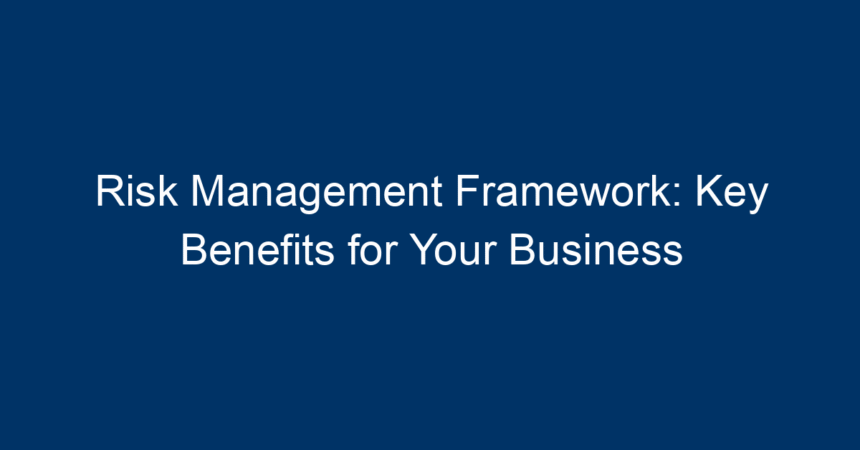In today’s dynamic and often unpredictable business landscape, understanding how to manage risks effectively is more crucial than ever. Companies are not only seeking to maximize profits but also to safeguard their assets, reputation, and longevity. A robust risk management framework is the answer. This comprehensive approach enables organizations to identify, analyze, and mitigate risks while uncovering opportunities for growth. In this article, we will explore the key benefits of implementing a risk management framework and how it can optimize your business performance.
Understanding the Risk Management Framework
Before diving into the benefits, it’s essential to clarify what a risk management framework entails. This structured approach combines processes, methodologies, tools, and techniques that businesses use to manage risks systematically. The main components of a risk management framework typically include:
- Risk Identification: Pinpointing potential risks that could impact business objectives.
- Risk Assessment: Analyzing the likelihood and impact of identified risks.
- Risk Response: Developing strategies to mitigate or capitalize on risks.
- Risk Monitoring: Regularly reviewing and updating the risk environment.
By harmonizing these components, businesses can navigate uncertainties more effectively.
Key Benefits of Implementing a Risk Management Framework
1. Enhanced Decision-Making
One of the most significant benefits of a risk management framework is the improvement in decision-making processes. When risks are identified and analyzed, organizations receive critical data that informs strategic choices. This evidence-based approach reduces uncertainty, enabling leaders to make informed decisions that align with the company’s objectives.
Actionable Insight:
Establish a culture of risk awareness within your organization. Foster open communication channels to ensure that employees at all levels feel comfortable reporting potential risks.
2. Improved Operational Efficiency
A comprehensive risk management framework can lead to enhanced operational efficiency. By proactively addressing potential risks, businesses can streamline processes and reduce downtime. Inefficiencies often stem from unforeseen challenges that could have been managed with foresight. Implementing a risk framework helps identify bottlenecks and inefficiencies before they escalate.
Actionable Insight:
Conduct regular risk assessments across different departments to find operational vulnerabilities. Use this data to refine processes and optimize resource allocation.
3. Regulatory Compliance and Legal Protection
In many industries, compliance with regulatory requirements is a must. A well-structured risk management framework ensures that your business adheres to legal obligations, reducing the likelihood of costly penalties and reputational damage. Compliance includes not only industry standards but also workplace safety regulations and environmental laws.
Actionable Insight:
Stay updated on relevant regulations in your industry and integrate compliance checks into your risk management framework. This will help protect your business from legal repercussions and build trust with stakeholders.
4. Financial Stability
Financial risks, such as market fluctuations, credit risks, and operational costs, can significantly impact a company’s bottom line. A robust risk management framework aids in assessing and managing financial risks, leading to better budgeting and forecasting. By understanding financial vulnerabilities, organizations can make smarter investments and minimize losses.
Actionable Insight:
Utilize scenario analysis to simulate different financial situations and their impacts on your business. This will help you be better prepared for unexpected financial downturns.
5. Strengthened Reputation and Stakeholder Trust
Transparency in risk management can enhance your organization’s reputation. Businesses that demonstrate a commitment to managing risks effectively often enjoy increased trust from customers, investors, and other stakeholders. A good reputation is not just beneficial for attracting new customers; it can also lead to increased loyalty and retention.
Actionable Insight:
Share your risk management initiatives with stakeholders. Regularly publish reports that highlight your company’s commitment to risk management and mitigation efforts.
6. Innovation and Opportunity Recognization
While risk management is primarily about mitigation, it can also reveal opportunities for innovation. Understanding risks allows businesses to pivot, adapt, and explore new markets or products. When risks are well-managed, organizations can focus on development rather than merely reacting to challenges.
Actionable Insight:
Encourage creative thinking and risk-taking in a controlled environment. Use brainstorming sessions to discuss potential risks and how they can be converted into new business opportunities.
7. Crisis Management and Resilience
An effective risk management framework prepares businesses for crises and unforeseen events, enabling them to respond swiftly and effectively. By identifying potential crises before they occur, organizations can develop contingency plans that minimize disruptions and maintain operations.
Actionable Insight:
Draft a crisis management plan that outlines roles, responsibilities, and actions to be taken during various scenarios. Regularly review and practice this plan to ensure preparedness.
8. Enhanced Employee Engagement and Safety
A risk management framework can improve workplace safety, leading to better employee engagement. Employees are more likely to feel valued and secure in an environment where risks are acknowledged and managed. This enhances morale, increases productivity, and reduces turnover rates.
Actionable Insight:
Implement regular training sessions on risk awareness and safety protocols. This promotes a culture of safety and empowers employees to voice concerns about potential hazards.
Conclusion: Building a Robust Risk Management Framework
Incorporating a comprehensive risk management framework into your business strategy is not just about avoiding pitfalls; it’s about harnessing the potential within uncertainties. The key benefits – from enhanced decision-making and operational efficiency to improved financial stability and stakeholder trust – underline the importance of risk management in today’s business landscape.
Final Thoughts
Actively engage your team in the risk management process, continually evolve your framework to meet emerging challenges, and always remain vigilant in your assessments. By taking these proactive steps, you will not only shield your company from potential risks but also position it for sustainable growth and success. Embrace the power of a well-structured risk management framework, and turn risks into opportunities that propel your business forward.
By following these insights, you’ll be well on your way to implementing a successful risk management framework that contributes positively to your organization’s goals and future.




